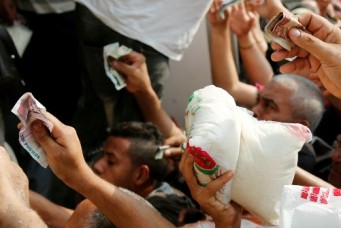Asia Model for Arab Reform
President Obama’s May 19 speech about change in the Middle East raises some important and enduring conundrums about politics and identity that apply to Asia as well as the Middle East. The U.S. wants to be on the right side of history, and has newly embraced the demand for reform and democracy as a higher-order determinant of U.S. policy priorities than the earlier emphasis on stability.
President Obama’s May 19 speech about change in the Middle East raises some important and enduring conundrums about politics and identity that apply to Asia as well as the Middle East. The U.S. wants to be on the right side of history, and has newly embraced the demand for reform and democracy as a higher-order determinant of U.S. policy priorities than the earlier emphasis on stability.
So change is now better than stability, at least in those places where the citizens demand it. It’s a very tricky process, to wean our official discourse and rhetoric from the past in those places where change has already occurred, and to preserve a more traditional posture where change has not happened, or where change may not be desirable from a U.S. point of view. The peaceful leadership transitions in Tunisia and Egypt were relatively easy to embrace; the violent upheavals in Libya and Yemen have resulted in international calls for leadership change, even without knowing what will follow. The crackdowns against protestors in Bahrain and Syria have kept us on the fence; we call for dialogue in the former and are slowly creeping to a call for President Assad to leave power in the latter. As the president’s recitation of this case-by-case approach indicated, in periods of dramatic transition, it’s hard to invoke universal principles when the realities of political change are messier and more confusing.
Asians went through similar convulsions a generation ago, with some of the same outcomes. Youth protestors ousted a dictatorship in Indonesia, the revolution in the Philippines was a reminder that positive political change does not guarantee relief from poverty, and some authoritarian regimes hold on for longer than thought possible. The belief in a democratic tsunami is often belied by weather patterns that change course and affect different locales in distinctly different ways.
So Obama’s speech somewhat awkwardly juxtaposed the universal cry for freedom, the right to self-determination, and other lofty global values with the national politics and cultures of places as different as Yemen, Bahrain, and Tunisia. Each Arab country has its own history; reform processes are playing out differently in the monarchies and in the republics, and the legitimacy quotient varies widely across the region. Those republics, including Egypt and Syria, which two generations ago were the champions of secular modernization, atrophied under leaders who didn’t know when to leave, while at least some of the monarchies prospered economically and pursued incremental reforms for publics that were largely quiescent and complacent. The secular republics could not deliver basic social services, and their legitimacy eroded slowly but surely. The short-term explosions of anger and frustration over the past decade did not seem to threaten the basic power equation within each of these Arab societies. U.S. policy often focused on near-term cooperation and shared interests in regional trends, such as keeping the Soviets at bay, or, more recently, thwarting Iranian ambitions or al-Qaeda predations, rather than on questions of political legitimacy and long-term domestic stability.
Today it is tempting, as in Asia a generation ago, to make some broad assertions about an inevitable pattern of change and the empowerment of Arab citizens across borders. The contagion effect of the uprising in Tunisia was surprising and yet not so. Pan-Arabism was a rallying cry in the 1960s that had cultural resonance (shared language, religion, history) and political meaning – the struggle for Palestine. Over the years, the belief in deeply shared identities was replaced with the particularisms of politics at the nation-state level, and young Arabs lost faith in the unity theme, and, for a while, seemed to lose interest in Palestine as the defining issue for Arab identity.
Yet the rise of pan-Arab media (and the declining credibility of state-run media) and the recently demonstrated power of social media managed to unite a new generation of Arabs, who have shared ideas and methods for mobilizing themselves and their societies in unprecedented ways. As outsiders, when we praise and encourage the political goals of Arabs in a place that is liberating itself, we run the risk of disappointing the would-be democrats in places where change is not underway or not likely to be. In a world of fast and borderless communications, it will be hard to manage the identity politics of a new generation of Arabs that feel connected yet live in very different political systems. As in Asia, the processes of reform and change happen at different paces and in distinct cultural settings. As tempting as it is to see broad patterns and strategic trends, the real work of improving lives and opening political space is a balancing act of how those big ideas play out in very varied locales.
Ellen Laipson is president and CEO of the Henry L. Stimson Center and a trustee of the Asia Foundation. This article originally appeared in the Asia Foundation’s In Asia blog http://asiafoundation.org/in-asia/.


